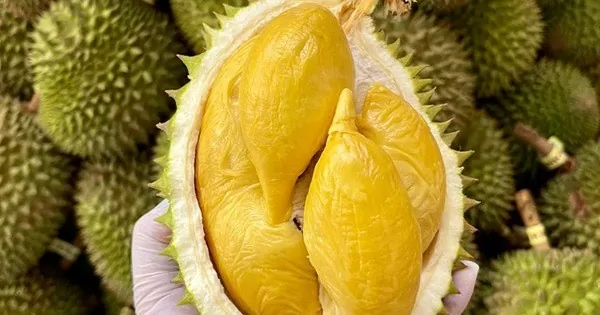The Import and Export Department (Ministry of Industry and Trade) cited data from the Chinese Customs Administration, saying that in the first 10 months of 2024, China imported approximately 1.5 million tons of durian, worth nearly 6.68 billion USD, up 10.1% in volume and 4.4% in value over the same period last year.
 |
| Vietnam earned more than 3 billion USD from durian exports in the first 10 months of 2024. Photo: MH |
Durian consumption in the Chinese market accounts for 91% of global consumption by 2023, showing the huge potential of this market.
Notably, although Thailand held the position of the largest durian supplier in the Chinese market in the first 10 months of 2024, it is facing great competition from Southeast Asian countries, typically Vietnam.
Specifically, China spent nearly 3.87 billion USD to import about 785,000 tons of durian from Thailand at an average price of 4,927 USD/ton. However, the quantity of durian imported from Thailand decreased by 13.2% and the value decreased by 12.7% compared to the same period last year.
Meanwhile, in the past 10 months, durian imports from Vietnam increased sharply by 55% in volume and 42.5% in value compared to the same period last year. Vietnamese durian accounted for 46.9% of China's durian imports, ranking second only to Thailand with 52.4%.
According to statistics from the General Department of Vietnam Customs, China's increased purchase of Vietnamese durian helped this fruit set a historical export record of over 3 billion USD in just 10 months, an increase of 45.7% over the same period in 2023. At the same time, it contributed greatly to the overall growth rate of the entire fruit and vegetable industry in the first 10 months of 2024, when the proportion accounted for 49.11% of the total turnover.
According to the Import-Export Department, although Thailand is the largest durian supplier in China in the first 10 months of 2024, it is facing great competition from Southeast Asian countries, typically Vietnam.
To protect its market share, Thailand is encouraged to focus on strengthening quality control and standards, addressing issues such as soft durians and pests. Innovating new durian varieties that suit consumer tastes could also give Thai durians a competitive edge in the Chinese market.
The China-Laos railway has significantly reduced the cost and time of transporting Thai durian, improving the competitiveness of the product. However, with the market approaching saturation, constant innovation and adaptation are imperative for Thai exporters to maintain their market leadership.
Speaking to reporters from the Industry and Trade Newspaper , Mr. Dang Phuc Nguyen - General Secretary of the Vietnam Fruit and Vegetable Association - said that this year, durian exports are expected to earn over 3.2 billion USD, an increase of more than 1 billion USD compared to last year.
Notably, although the Vietnamese durian industry has only developed since 2023, while Thai or Malaysian durian has been developing for decades, Vietnamese durian has also made major competitors wary in the Chinese market.
On the other hand, while Thai or Malaysian durian season only lasts 3-4 months, Vietnamese durian is available all year round. Along with the advantage in logistics, it is expected that durian exports will continue to expand in the Chinese market.
Not being subjective to her competitors, Ms. Phan Thi Men - General Director of SUTECH Science and Technology Consulting Co., Ltd. - informed that currently, on the shelves selling durian at shopping centers in Beijing, most of them do not have Vietnamese durian but mainly durian from Thailand and Malaysia.
In the shopping mall, for fresh durian, it is mainly Dona durian from Thailand, and for frozen durian, it is mainly frozen whole Musangking durian from Malaysia. While in Vietnam, type C durian is often frozen, Thai durian is still sold as type C. Regarding frozen durian, in China, people are extremely fond of frozen whole durian from Malaysia.
To gain a piece of the market share in this billion-people market, Ms. Phan Thi Men recommends that farmers, cooperatives, businesses and the government need to take measures to change and promote the quality and appearance of durian in particular and agricultural products in general. At the same time, there should be connection strategies to increase access to the Chinese people. Only then can Vietnamese durian dominate the Chinese market.



